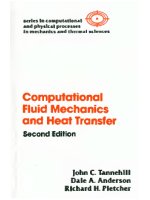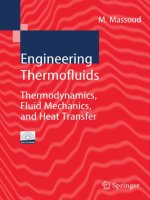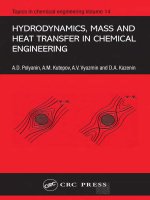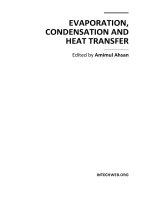boundary layer flow and heat transfer with variable fluid properties on a moving flat plate in a parallel free stream
Bạn đang xem bản rút gọn của tài liệu. Xem và tải ngay bản đầy đủ của tài liệu tại đây (271.15 KB, 11 trang )
Hindawi Publishing Corporation
Journal of Applied Mathematics
Volume 2012, Article ID 372623, 10 pages
doi:10.1155/2012/372623
Research Article
Boundary Layer Flow and Heat Transfer with
Variable Fluid Properties on a Moving Flat Plate in
a Parallel Free Stream
Norfifah Bachok,1 Anuar Ishak,2 and Ioan Pop3
1
Department of Mathematics and Institute for Mathematical Research, Universiti Putra Malaysia,
43400 UPM Serdang, Selangor, Malaysia
2
School of Mathematical Sciences, Faculty of Science and Technology, Universiti Kebangsaan Malaysia,
43600 UKM Bangi, Selangor, Malaysia
3
Faculty of Mathematics, University of Cluj, CP 253, Romania
Correspondence should be addressed to Anuar Ishak,
Received 23 March 2012; Accepted 26 April 2012
Academic Editor: Srinivasan Natesan
Copyright q 2012 Norfifah Bachok et al. This is an open access article distributed under the
Creative Commons Attribution License, which permits unrestricted use, distribution, and
reproduction in any medium, provided the original work is properly cited.
The steady boundary layer flow and heat transfer of a viscous fluid on a moving flat plate
in a parallel free stream with variable fluid properties are studied. Two special cases, namely,
constant fluid properties and variable fluid viscosity, are considered. The transformed boundary
layer equations are solved numerically by a finite-difference scheme known as Keller-box method.
Numerical results for the flow and the thermal fields for both cases are obtained for various values
of the free stream parameter and the Prandtl number. It is found that dual solutions exist for both
cases when the fluid and the plate move in the opposite directions. Moreover, fluid with constant
properties shows drag reduction characteristics compared to fluid with variable viscosity.
1. Introduction
The problem of forced convection flow and heat transfer past a continuously moving flat
plate is a classical problem of fluid mechanics and has attracted considerable interest of
many researchers not only because of its many practical applications in various extrusion
processes but also because of its fundamental role as a basic flow problem in the boundary
layer theory of Newtonian and non-Newtonian fluid mechanics. It has been solved for the
first time in 1961 by Sakiadis 1 . Thereafter, many solutions have been obtained for different
situations of this class of boundary layer problems. The solutions for the cases when the mass
transfer effect is included fluid injection and fluid suction , chemical effects are considered,
constant or variable surface temperatures, and other situations have been reported by Klemp
and Acrivos 2 , Abdelhafez 3 , Hussaini et al. 4 , Afzal et al. 5 , Bianchi and Viskanta 6 ,
2
Journal of Applied Mathematics
Lin and Huang 7 , Chen 8 , Magyari and Keller 9 , Afzal 10 , Fang 11, 12 , Sparrow and
Abraham 13 , and Weidman et al. 14 , among others. However, it seems that the existence
of dual solutions was reported only in the papers by Afzal et al. 5 , Afzal 10 , Fang 11, 12 ,
Weidman et al. 14 , Riley and Weidman 15 , Fang et al. 16 and Ishak et al. 17 .
The work by Pop et al. 18 belongs to the above class of problems, including the
variation of fluid viscosity with temperature. The authors obtained similarity solutions
considering that viscosity varies as an inverse function of temperature for two distinct
Prandtl numbers 0.7 and 10.0. Exactly the same approach was taken by Elbashbeshy
and Bazid 19 who reported results for Prandtl numbers 0.7 and 7.0. Pantokratoras 20
reconsidered the problem investigated earlier by Pop et al. 18 with the view to allow
for the temperature-dependency on the Prandtl number. Fang 21 studied the influences
of temperature-dependent fluid properties on the boundary layers over a continuously
stretching surface with constant temperature. Andersson and Aarseth 22 presented a
rigorous approach for proper treatment of variable fluid properties in the Sakiadis 1 flow
problem. They presented a generalized similarity transformation which enables the analysis
of the influence of temperature-dependent fluid properties. New and interesting results
for water at atmospheric pressure were reported. The objective of the present paper is,
therefore, to extend the paper by Andersson and Aarseth 22 to the case when the plate
moves in a parallel free stream, a case that has not been considered before in the literature.
Thus, following Andersson and Aaresth 22 , the governing partial differential equations are
transformed using similarity transformation to a system of ordinary differential equations,
which is more convenient for numerical computations. The transformed nonlinear ordinary
differential equations are solved numerically for certain values of the governing parameters
using the Keller-box method. This method has been very successfully used by the present
authors for other fundamental problems, see Ishak et al. 23 and Bachok et al. 24, 25 .
2. Problem Formulation
Consider a steady two-dimensional boundary layer flow on a fixed or continuously moving
flat plate in a parallel free stream of a viscous fluid. It is assumed that the plate moves with a
constant velocity Uw in the same or opposite directions to the free stream of constant velocity
U0 . The ambient fluid and the moving plate are kept at constant temperatures T0 and Tw ,
where Tw > T0 heated plate . Under these conditions, the boundary layer equations of this
problem are given by, see Andersson and Aarseth 22 ,
∂
ρu
∂x
ρ u
∂u
∂x
ρCp u
v
∂T
∂x
∂
ρv
∂y
∂u
∂y
v
0,
∂
∂u
μ
,
∂y
∂y
∂T
∂y
2.1
∂
∂T
k
,
∂y
∂y
subject to the boundary conditions
u
Uw ,
v
u −→ U0 ,
0,
T
T −→ T0
Tw
at y
0,
as y → ∞,
2.2
Journal of Applied Mathematics
3
where x and y are coordinates measured along the surface and normal to it, respectively.
Further, u and v are the velocity components in the x and y directions, respectively, T is
the fluid temperature, ρ is the fluid density, μ is the dynamic viscosity, k is the thermal
conductivity and Cp is the specific heat at constant pressure. The similarity variable η and
the new dependent variables f and θ are defined as, see Andersson and Aarseth 22 ,
U
aυ0 x
η
1/2
ρ/ρ0 dy,
ρ0 aυ0 xU
ψ x, y
1/2
2.3
2.4
f η ,
T − T0
,
Tw − T0
θ η
2.5
where U
Uw U0 , a is a dimensionless positive constant, and ψ is the stream function,
which is defined as
ρu
∂ψ
,
∂y
ρv
−
∂ψ
.
∂x
2.6
Further, ρ0 , μ0 , k0 , Cp0 , and υ0 are the values of the fluid properties of the ambient fluid, that
is, at temperature T0 . Using 2.3 – 2.5 , the partial differential equation 2.1 can be reduced
to the following nonlinear ordinary differential equations
2 ρμ
f
a ρ0 μ 0
ff
aCp
Pr0 fθ
2Cp0
ρk
θ
ρ 0 k0
2.7
0,
2.8
0,
where Pr0 is the constant Prandtl number of the ambient fluid and primes denote
differentiation with respect to η. Equations 2.7 and 2.8 are subjected to the boundary
conditions 2.2 , which become
f 0
f η
f 0
0,
ε,
θ η
1 − ε,
θ 0
0
as η −→ ∞,
1
2.9
where ε is the free stream parameter since it gives the relative importance of the free stream
velocity and is defined as
ε
U0
U
U0
.
U0 Uw
2.10
It should be mentioned that ε 1/2 corresponds to a free stream velocity equal to the moving
plate velocity, ε
1 corresponds to the classical Blasius flow, and ε
0 is for the case of
4
Journal of Applied Mathematics
a moving flat plate in a quiescent fluid Sakiadis flow . Thus, for ε 0, 2.7 and 2.8 along
with the boundary conditions 2.9 reduce to 2.9 – 2.11 of the paper by Andersson and
Aarseth 22 . The case where both the free stream and the plate velocities are in the same
direction corresponds to 0 < ε < 1. If ε > 1, the free stream is directed towards the positive
x-direction while the plate moves towards the negative x-direction. If ε < 0, the free stream
is directed towards the negative x-direction while the plate moves towards the positive xdirection see Afzal et al. 5 . However, in this paper, we consider only the case ε ≥ 0, that is
the free stream is fixed towards the positive x-direction .
The physical quantities of interest are the surface shear stress τw and the surface heat
flux qw , which can be expressed as
μw
τw
qw
1/2
U3
aυ0 x
f 0,
2.11
1/2
U
aυ0 x
μw Cp0 Pr−1
0 ΔT
−θ 0 .
3. Special Cases
3.1. Constant Fluid Properties (Case A)
In this case, the similarity variable η defined in 2.3 simplifies to the Blasius 26 variable
1/2
U
aυ0 x
η
3.1
y,
and 2.7 and 2.8 reduce to
2
f
a
θ
ff
3.2
0,
a
Pr0 fθ
2
0,
3.3
which are still subjected to the boundary conditions 2.9 . 3.2 is the extended Blasius
equation, where the solution subjected to the boundary conditions 2.9 when ε
1 was
reported by Fang 27 .
3.2. Variable Viscosity (Case B)
Pop et al. 18 allowed only for a temperature, dependent viscosity, whereas the other fluid
properties were assumed to be constant. This assumption was then followed by Elbashbeshy
and Bazid 19 and Pantokratoras 20 . In this approximation, the similarity variable 2.3
simplifies to 3.1 and the momentum boundary layer 2.7 becomes
2 μ
f
a μ0
ff
0.
3.4
Journal of Applied Mathematics
5
Following the form of the variable viscosity μ T proposed by Lai and Kulacki 28 , and used
by Pop et al. 18 and Andersson and Aarseth 22 , we take μ T as
μ T ≈
1
μref
,
γ T − Tref
3.5
where γ is a fluid property, which depends on the reference temperature Tref . In general, the
viscosity of liquids decreases with increasing temperature γ > 0 , whereas it increases for
gases γ < 0 . However, if the reference temperature is taken as T0 , the relation 3.5 can be
written as
μ T
μ0
1 − T − T0 / Tw − T0 θref
μ0
,
1 − θ η /θref
3.6
where θref is a dimensionless constant defined as θref ≡ −1/ Tw − T0 γ and Tw − T0 is the
operating temperature difference ΔT .
4. Results and Discussion
The nonlinear ordinary differential equations 3.2 or 3.4 , depending on the actual
case considered, along with 3.3 subject to the boundary conditions 2.9 were solved
numerically using a very efficient implicit finite-difference scheme known as Keller-box
method, which is very well described in the book by Cebeci and Bradshaw 29 . In the general
context, empirical correlations for all required fluid properties can be recast in terms of the
dimensionless temperature θ η as defined in 2.5 . The proper relations take then the forms
like, for example 3.6 . The generalized boundary value problem 2.7 – 2.9 is apparently a
three-parameter problem of which the solution depends on T0 , and ΔT ≡ Tw − T0 , together
with the Prandtl number Pr0 of the ambient fluid. The Prandtl number Pr0 is, however,
uniquely related to the ambient temperature T0 and the boundary value problem 2.7 – 2.9
is actually a two-parameter problem in T0 or Pr0 and ΔT . The present paper focuses on the
effects of a temperature-dependent viscosity only, and the other fluid properties are assumed
to be constant. First, however, the numerical solution of the classical problem moving plate
in a quiescent fluid, ε 0 with constant fluid properties was computed for Prandtl number
Pr0 0.7, 1, and 10. The characteristic surface gradients f 0 and θ 0 are compared with
Andersson and Aarseth 22 in Table 1 and serve primarily to validate the accuracy of
the present solution technique. In order to illustrate the effect of a temperature-dependent
viscosity, two different cases have been solved. The ambient fluid considered is water at
278 K 5◦ C and Pr0
10. The surface temperature is Tw
358 K 85◦ C
temperature T0
such that the operating temperature difference ΔT ≡ Tw − T0 is 80 K. Results for problem with
constant fluid properties Case A are compared with those of the inversely linear viscosity
variation 3.5 , 3.6 Case B . In 3.5 , 3.6 , we set θref −0.25 for water at T0 278 K, as
recommended by Ling and Dybbs 30 . The characteristic surface gradients f 0 and θ 0
for Pr0 10 are obtained and compared with previously reported cases, and the comparison
is shown in Table 2. It is seen from Tables 1 and 2 that the values of f 0 and θ 0 obtained
in this study are in very good agreement with the results reported by Andersson and Aarseth
22 . Therefore, it can be concluded that the developed code can be used with great confidence
to study the problem considered in this paper.
6
Journal of Applied Mathematics
Table 1: Values of the reduced skin friction coefficient f 0 and reduced heat flux θ 0 at the moving
surface for Pr0 0.7, 1, and 10 when a 1 in Case A: constant fluid properties.
ε
Pr0
a
0
0
0
0.7
1
10
1
1
1
Andersson and Aarseth 22
−f 0
−θ 0
0.4437483
—
—
0.3492365
—
—
Present results
−f 0
−θ 0
0.4437
0.4437
0.4437
0.3492
0.4437
1.6803
Table 2: Values of the reduced skin friction f 0 and reduced heat flux at the moving surface for Pr0
1, Pr0 10, and a 1 in both Cases A and B.
ε
0
Pr0
a
10
1
1
1
Case A
Case B
0
Case A
Case B
Andersson and Aarseth 22
Present results
−f 0
0.443748
1.300553
−θ 0
1.680293
1.529151
−f 0
0.4437
1.3006
−θ 0
1.6803
1.5292
—
—
—
—
0.4437
1.0381
0.4437
0.3181
The variations of the reduced skin friction coefficient f 0 and reduced local Nusselt
number −θ 0 with the free stream parameter ε for both Cases A and B considered are
shown in Figures 1 and 2, respectively. The values of f 0 are positive when ε > 0.5, while
they are negative when ε < 0.5. Physically, a positive sign of f 0 implies that the fluid
exerts a drag force on the plate and a negative sign implies the opposite. It can be seen
from these figures that the existence of dual solutions when ε > 1 the plate moves in the
opposite direction of the free stream with two branch solutions: upper and lower branches.
The solution for both Cases A and B exists up to a critical value of ε εc say . This value
of εc increases as the Prandtl number Pr is increased, as shown in Figures 1 and 2. Further,
it is evident from Figure 1 that the absolute value of f 0 is larger for Case B compared to
Case A. Thus, fluid with constant properties shows drag reduction characteristics compared
to fluid with variable viscosity. Moreover, the range of ε for which the solution exists is larger
for Case B compared to Case A. It is worth mentioning that, for the case of constant fluid
properties, Weidman et al. 14 have shown using a stability analysis that the upper branch
solutions are stable, while the lower branch solutions are not. We expect that this observation
is also true for the present problem.
The computed velocity profiles f η and temperature profiles θ η are shown in
Figures 3 and 4, respectively. One can see that the velocity profiles f η in Figure 3 are
substantially reduced near the moving surface for Case B as compared with Case A. The
moving surface heats the adjacent fluid and thereby reduces its viscosity. Viscous diffusion
of streamwise momentum from the surface towards the ambient is accordingly reduced in
the inner part of the momentum boundary layer. The temperature profiles in Figure 4 show
a higher temperature near the surface due to this reduced viscosity. Figures 3 and 4 show
that the far field boundary conditions are approached asymptotically, which support the
validity of the numerical results obtained. It is worth mentioning that the results presented
30, much larger than shown in these figures.
in Figures 3 and 4 were produced with η∞
This integration length is sufficiently long to satisfy f → 0 and θ → 0 which is a necessary
condition pointed out by Andersson and Aarseth 22 .
Journal of Applied Mathematics
7
2
Pr0 = 10, a = 1
1.5
Pr0 = 1, a = 1
f ′′ (0)
1
0.5
0
−0.5
−1
0
0.5
1
ε
1.5
2
Case A
Case B
Figure 1: Variation of the reduced skin friction f 0 with ε for different values of Pr0 when a 1. Case
A solid line : constant viscosity and Case B dotted line : inversely linear viscosity, 3.5 , and 3.6 .
1.6
a=1
1.4
1.2
Pr0 = 10
−θ′ (0)
1
0.8
Pr0 = 1
0.6
0.4
0.2
0
0
0.5
1
1.5
2
ε
Case A
Case B
Figure 2: Variation of the reduced heat flux −θ 0 with ε for different values of Pr0 when a 1. Case A
solid line : constant viscosity and Case B dotted line : inversely linear viscosity, 3.5 , and 3.6 .
5. Conclusions
In the present paper, we have studied numerically the problem of steady boundary layer flow
with variable fluid properties on a moving flat plate in a parallel free stream. The governing
partial differential equations are transformed using similarity transformation to a more
8
Journal of Applied Mathematics
1
0.8
f ′ (η)
0.6
0.4
ε = 0.3
0.2
ε = 0.1
0
ε=0
0
2
4
6
η
8
10
12
Case A
Case B
Figure 3: Dimensionless velocity profiles f η for different values of ε when Pr0 1 and a 1. Case A
solid line : constant viscosity and Case B dotted line : inversely linear viscosity, 3.5 , and 3.6 .
1
0.9
0.8
0.7
Pr0 = 0.72
θ (η)
0.6
0.5
Pr0 = 1
0.4
Pr0 = 10
0.3
0.2
0.1
0
0
5
10
η
15
20
Case A
Case B
Figure 4: Dimensionless temperature profiles θ η for different values of Pr0 when ε 0 and a 1. Case A
solid line : constant viscosity and Case B dotted line : inversely linear viscosity, 3.5 , and 3.6 .
convenient form for numerical computation. The transformed nonlinear ordinary differential
equations were solved numerically using the Keller-box method. Numerical results for the
skin friction coefficient and the local Nusselt number as well as the velocity and temperature
profiles are illustrated in two tables and some graphs for various parameter conditions. Two
special cases, namely, constant fluid properties and variable fluid viscosity, were considered.
It was found that dual solutions exist when the plate and the free stream move in the opposite
Journal of Applied Mathematics
9
directions, for both cases considered. Moreover, fluid with constant properties show drag
reduction characteristics compared to fluid with variable viscosity.
Acknowledgments
The authors wish to express their thanks to the reviewers for the valuable comments and
suggestions. This work was supported by a research grant UKM-GUP-2011-202 from the
Universiti Kebangsaan Malaysia.
References
1 B. C. Sakiadis, “Boundary layer behavior on continuous solid surface: the boundary layer on a
continuous flat surface,” AIChE Journal, vol. 7, pp. 221–225, 1961.
2 J. B. Klemp and A. Acrivos, “A method for integrating the boundary-layer equations through a region
of reverse flow,” The Journal of Fluid Mechanics, vol. 53, pp. 177–191, 1972.
3 T. A. Abdelhafez, “Skin friction and heat transfer on a continuous flat surface moving in a parallel
free stream,” International Journal of Heat and Mass Transfer, vol. 28, no. 6, pp. 1234–1237, 1985.
4 M. Y. Hussaini, W. D. Lakin, and A. Nachman, “On similarity solutions of a boundary layer problem
with an upstream moving wall,” SIAM Journal on Applied Mathematics, vol. 47, no. 4, pp. 699–709, 1987.
5 N. Afzal, A. Badaruddin, and A. A. Elgarvi, “Momentum and heat transport on a continuous flat
surface moving in a parallel stream,” International Journal of Heat and Mass Transfer, vol. 36, no. 13, pp.
3399–3403, 1993.
6 M. V. A. Bianchi and R. Viskanta, “Momentum and heat transfer on a continuous flat surface moving
in a parallel counterflow free stream, Wăarme-Und Stoubertragung,
vol. 29, no. 2, pp. 8994, 1993.
ă
7 H.-T. Lin and S.-F. Huang, “Flow and heat transfer of plane surfaces moving in parallel and reversely
to the free stream,” International Journal of Heat and Mass Transfer, vol. 37, no. 2, pp. 333–336, 1994.
8 C. H. Chen, “Heat transfer characteristics of a non-isothermal surface moving parallel to a free
stream,” Acta Mechanica, vol. 142, no. 1, pp. 195–205, 2000.
9 E. Magyari and B. Keller, “Exact solutions for self-similar boundary-layer flows induced by permeable
stretching walls,” European Journal of Mechanics. B. Fluids, vol. 19, no. 1, pp. 109–122, 2000.
10 N. Afzal, “Momentum transfer on power law stretching plate with free stream pressure gradient,”
International Journal of Engineering Science, vol. 41, no. 11, pp. 1197–1207, 2003.
11 T. Fang, “Similarity solutions for a moving-flat plate thermal boundary layer,” Acta Mechanica, vol.
163, no. 3-4, pp. 161–172, 2003.
12 T. Fang, “Further study on a moving-wall boundary-layer problem with mass transfer,” Acta
Mechanica, vol. 163, no. 3-4, pp. 183–188, 2003.
13 E. M. Sparrow and J. P. Abraham, “Universal solutions for the streamwise variation of the temperature
of a moving sheet in the presence of a moving fluid,” International Journal of Heat and Mass Transfer,
vol. 48, no. 15, pp. 3047–3056, 2005.
14 P. D. Weidman, D. G. Kubitschek, and A. M. J. Davis, “The effect of transpiration on self-similar
boundary layer flow over moving surfaces,” International Journal of Engineering Science, vol. 44, no.
11-12, pp. 730–737, 2006.
15 N. Riley and P. D. Weidman, “Multiple solutions of the Falkner-Skan equation for flow past a
stretching boundary,” SIAM Journal on Applied Mathematics, vol. 49, no. 5, pp. 1350–1358, 1989.
16 T. Fang, W. Liang, and Chia-f.F. Lee, “A new solution branch for the Blasius equation—a shrinking
sheet problem,” Computers & Mathematics with Applications, vol. 56, no. 12, pp. 3088–3095, 2008.
17 A. Ishak, R. Nazar, and I. Pop, “Flow and heat transfer characteristics on a moving flat plate in a
parallel stream with constant surface heat flux,” Heat and Mass Transfer/Waerme- und Stoffuebertragung,
vol. 45, no. 5, pp. 563–567, 2009.
18 I. Pop, R. S. R. Gorla, and M. Rashidi, “The effect of variable viscosity on flow and heat transfer to a
continuous moving flat plate,” International Journal of Engineering Science, vol. 30, no. 1, pp. 1–6, 1992.
19 E. M. A. Elbashbeshy and M. A. A. Bazid, “The effect of temperature-dependent viscosity on heat
transfer over a continuous moving surface,” Journal of Physics D, vol. 33, no. 21, pp. 2716–2721, 2000.
20 A. Pantokratoras, “Further results on the variable viscosity on flow and heat transfer to a continuous
moving flat plate,” International Journal of Engineering Science, vol. 42, no. 17-18, pp. 1891–1896, 2004.
10
Journal of Applied Mathematics
21 T. Fang, “Influences of fluid property variation on the boundary layers of a stretching surface,” Acta
Mechanica, vol. 171, no. 1-2, pp. 105–118, 2004.
22 H. I. Andersson and J. B. Aarseth, “Sakiadis flow with variable fluid properties revisited,”
International Journal of Engineering Science, vol. 45, no. 2–8, pp. 554–561, 2007.
23 A. Ishak, R. Nazar, N. Bachok, and I. Pop, “MHD mixed convection flow near the stagnation-point on
a vertical permeable surface,” Physica A, vol. 389, no. 1, pp. 40–46, 2010.
24 N. Bachok, A. Ishak, and I. Pop, “Mixed convection boundary layer flow near the stagnation point on
a vertical surface embedded in a porous medium with anisotropy effect,” Transport in Porous Media,
vol. 82, no. 2, pp. 363–373, 2010.
25 N. Bachok, A. Ishak, and I. Pop, “Boundary-layer flow of nanofluids over a moving surface in a
flowing fluid,” International Journal of Thermal Sciences, vol. 49, no. 9, pp. 1663–1668, 2010.
26 H. Blasius, Grenzschichten in Flussigkeiten
mit kleiner Reibung, Zeitschrift fur
ă Angewandte
ă
Mathematik und Physik, vol. 56, pp. 1–37, 1908.
27 T. Fang, F. Guo, and Chia-f.F. Lee, “A note on the extended Blasius equation,” Applied Mathematics
Letters, vol. 19, no. 7, pp. 613–617, 2006.
28 F. C. Lai and F. A. Kulacki, “The effect of variable viscosity on convective heat transfer along a vertical
surface in a saturated porous medium,” International Journal of Heat and Mass Transfer, vol. 33, no. 5,
pp. 1028–1031, 1990.
29 T. Cebeci and P. Bradshaw, Physical and Computational Aspects of Convective Heat Transfer, Springer
Study Editions, Springer, New York, NY, USA, 1988.
30 J. X. Ling and A. Dybbs, “The effect of variable viscosity on forced convection over a flat plate
submersed in a porous medium,” Journal of Heat Transfer, vol. 114, no. 4, pp. 1063–1065, 1992.
Copyright of Journal of Applied Mathematics is the property of Hindawi Publishing Corporation and its content
may not be copied or emailed to multiple sites or posted to a listserv without the copyright holder's express
written permission. However, users may print, download, or email articles for individual use.









